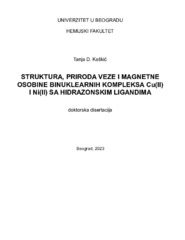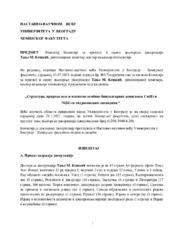Приказ основних података о дисертацији
Struktura, priroda veze i magnetne osobine binuklearnih kompleksa Cu(II) i Ni(II) sa hidrazonskim ligandima
Structure, nature of bond and magnetic properties of binuclear complexes Cu(II) and Ni(II) with hydrazone ligands
| dc.contributor.advisor | Anđelković, Katarina | |
| dc.contributor.other | Zlatar, Matija | |
| dc.contributor.other | Čobeljić, Božidar | |
| dc.contributor.other | Gruden-Pavlović, Maja | |
| dc.contributor.other | Radanović, Dušanka | |
| dc.creator | Keškić, Tanja M. | |
| dc.date.accessioned | 2024-03-20T07:49:30Z | |
| dc.date.available | 2024-03-20T07:49:30Z | |
| dc.date.issued | 2023-11-02 | |
| dc.identifier.uri | https://eteze.bg.ac.rs/application/showtheses?thesesId=9592 | |
| dc.identifier.uri | https://fedorabg.bg.ac.rs/fedora/get/o:33169/bdef:Content/download | |
| dc.identifier.uri | https://plus.cobiss.net/cobiss/sr/sr/bib/139121673 | |
| dc.identifier.uri | https://nardus.mpn.gov.rs/handle/123456789/22329 | |
| dc.description.abstract | U ovoj disertaciji opisana je sinteza, detaljna karakterizacija i kristalna struktura kompleksnih jedinjenja [CuL 1Cl]BF4 (1), [CuL 1Cl]NO3 (2), [Cu2L 12Cl2](BF4 )2 (3) i [Ni 2L 12 (μ-1,1-N3 )2 (N3 )2]⋅6H2 O (4), dobijenih u reakciji odgovarajućih Cu(II) i Ni(II) jona i liganda (E)-N,N,N-trimetil-2-okso-2-(2-(1-(piridin-2-il) etiliden(hidrazinil)etan-1-aminijum-hlorida (HL 1Cl) i kompleksa [Ni2L 22 (μ-1,1 -N3 )2 (N3 )2]∙2H2 O (5a) i [Ni 2L 22 (μ-1,1 -N3 )2 (N3 )2]∙4H2 O (5b) dobijenih u sintezi Ni(II) jona i liganda (E)-N,N,N-trimetil-2-okso-2-(2-(1-(tiazol-2-il)etiliden)hidrazinil)etan-1- aminijum-hlorida, (HL 2Cl). Navedeni kompleksi (1–5) detaljno su okarakterisani. Karakterizacija u čvrstom stanju rađena je pomoću IC spektroskopije, elementalne i rendgenske strukturne analize, dok je za komplekse 5a i 5b izmerena i magnetna susceptiblinost. Kod svih kompleksa 1–5 ligandi HL 1Cl i HL 2Cl koordinovani su tridentatno preko NNO donorskih atoma u deprotonovanom, formalno neutralnom, cviter-jonskom obliku. U slučaju kompleksa 1 i 2 metalni joni sa ligandom HL1Cl grade mononuklearne komplekse, dok u slučaju kompleksa 3 i 4 sa istim ligandom formiraju se binuklearni kompleski. Ligand HL 2Cl sa jonima Ni(II) gradi binuklearne komplekse 5a i 5b. Kompleksi 5a i 5b dobijeni su iz istog rastvora pri čemu je kompleks 5a pronađen samo u tragovima. Za sve komplekse urađeni su DFT proračuni, čiji rezultati su bili u skladu sa podacima dobijenim eksperimentalnim putem. DFT proračuni su pokazali da u slučaju mononuklearnih kompleksa 1 i 2, postoji slaba koordinativna veza između centralnog metalnog jona Cu(II) i anjona BF4– i NO3–, koja je izrazitog jonskog karaktera. Kod kompleksa 3 DFT proračuni su pokazali da kompleks postoji kao binuklearna vrsta, kod koje su dva Cu(II) jona međusobno povezana mosnim Cl– ligandima i da BF4– anjon nije uključen u koordinaciju sa Cu(II). Kod kompleksa 4, DFT proračuni pokazali su da nezavisno od primenjenih funkcionala, između metalnih centara postoji feromagnetno kuplovanje. U kompleksima 5a i 5b izračunata magnetna interakcija prema DFT pristupu sa meta- hibridnim M06-2X i dvostruko hibridnim B2PLYP i PWPB95 funkcionalima pokazuje da u svim slučajevima, model sistemi zasnovani na 5b imaju niže energije od onih zasnovanih na 5a. Takođe, i u slučaju optimizovanih struktura 5a* i 5b* (na BP86-D4/TZP nivou teorije), optimizovana struktura 5b* ima nižu energiju. Za komplekse 5a i 5b urađeno je i merenje temperaturno zavisne magnetne susceptibilnosti, koje je pokazalo da su intramolekulske interakcije između Ni(II) centara feromagnetne. | sr |
| dc.description.abstract | This thesis describes the synthesis, full characterisation and crystal structure of the complexes [CuL 1Cl]BF4 (1), [CuL 1Cl]NO3 (2), [Cu2L 12Cl2](BF4 )2 (3) and [Ni 2L 12 (μ-1,1-N3 )2 (N3 )2]⋅6H2 O (4), obtained in the reaction of the corresponding Cu(II) and Ni(II) ions and the ligand (E)-N,N,N-trimethyl-2-oxo-2-(2-(1-(pyridin-2-yl)ethylidene)hydrazinyl)ethan-1-aminium chloride (HL 1Cl) and complexes [Ni 2L 22 (μ-1,1 -N3 )2 (N3 )2]∙2H2 O (5a) and [Ni 2L 22 (μ-1,1 -N3 )2 (N3 )2]∙4H2 O (5b) obtained in the synthesis of Ni(II) ions and the ligand (E)-N,N,N-2-oxo-2-(2-(1-(thiazol-2- yl)ethylidene)hydrazinyl)ethan-1-aminium chloride, (HL 2Cl). All mentioned complexes were characterized in detail. Solid-state characterisation was carried out by infrared spectroscopy, elemental and X-ray structural analysis, and magnetic susceptibility was also measured for complexes 5a and 5b. In all complexes 1–5, the ligands HL 1Cl and HL 2Cl are tridentately coordinated via a set of NNO donor atoms in a formally neutral, deprotonated, zwitterionic form. In the case of complexes 1 and 2, metal ions with the HL 1Cl ligand form mononuclear complex, while in the case of complexes 3 and 4 with the same ligand, binuclear complex is formed. Ligand HL 2Cl with Ni(II) ions builds binuclear complexes 5a and 5b. Complexes 5a and 5b were obtained from the same solution, with complex 5a found only in trace amounts. DFT calculations were performed for all complexes, the results of which were in accordance with the experimental data. DFT calculations showed that in the case of mononuclear complexes 1 and 2, there is a weak coordination bond between the metal ion Cu(II) and the anions BF4– i NO3–, which is of a typical ionic type. For complex 3, DFT calculations showed that the complex exists as a binuclear species, in which two Cu(II) ions are connected to each other by bridging Cl– ligands and that the BF4– anion is not involved in coordination with Cu(II). In the case of complex 4, DFT calculations showed that independently of the applied functionals, ferromagnetic coupling exists between the metal centers. In complexes 5a and 5b, the calculated magnetic interaction according to the DFT approach with meta-hybrid M06-2X and doubly hybrid B2PLYP and PWPB95 functionals shows that in all cases, the model systems based on 5b have lower energy level than those based on 5a. Also, in the case of the optimized structures 5a* and 5b* (at the BP86-D4/TZP level of theory), the optimized structure 5b* has a lower energy state. For complexes 5a and 5b, a temperature-dependent magnetic susceptibility was also measured, which showed that intramolecular interactions between Ni(II) centers are ferromagnetic in nature | en |
| dc.format | application/pdf | |
| dc.language | sr | |
| dc.publisher | Универзитет у Београду, Хемијски факултет | sr |
| dc.rights | openAccess | en |
| dc.rights.uri | https://creativecommons.org/licenses/by-nc-nd/4.0/ | |
| dc.source | Универзитет у Београду | sr |
| dc.subject | kompleksi d-metala, hidrazonski ligandi, kristalna struktura, magnetne osobine, teorija funkcionala gustine, računarska hemija | sr |
| dc.subject | d-metal complexes, hydrazone ligands, crystal structure, magnetic properties, density functional theory, computational chemistry | en |
| dc.title | Struktura, priroda veze i magnetne osobine binuklearnih kompleksa Cu(II) i Ni(II) sa hidrazonskim ligandima | sr |
| dc.title.alternative | Structure, nature of bond and magnetic properties of binuclear complexes Cu(II) and Ni(II) with hydrazone ligands | en |
| dc.type | doctoralThesis | |
| dc.rights.license | BY-NC-ND | |
| dc.identifier.fulltext | http://nardus.mpn.gov.rs/bitstream/id/160246/Disertacija_15214.pdf | |
| dc.identifier.fulltext | http://nardus.mpn.gov.rs/bitstream/id/160247/Izvestaj_Komisije_15214.pdf | |
| dc.identifier.rcub | https://hdl.handle.net/21.15107/rcub_nardus_22329 |



